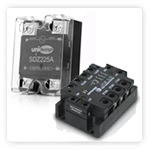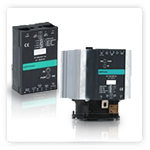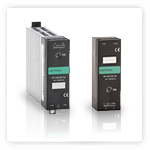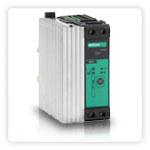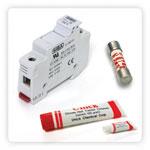Solid State Relays
More Information

Solid state switching devices are used in most modern automation systems to switch electrical loads. They offer high durability where a high number of switching operations or a fast switching speed is required.
Further benefits are resistance to mechanical shock or vibration, moisture and dust as well as silent operation, maintenance free service and reduction of electromagnetic noise.
Switching is initiated by applying a low DC signal (typically 4-32VDC, 4mA) to the trigger input, placing less demand on control outputs and enhancing safety.
SSRs are normally "zero crossover switching", only closing or opening when the AC power sine wave crosses zero. This eliminates electromagnetic interference and harmonics on the power supply.
contact us to discuss your requirements.
Universal
SSRs
- Reliable switching of electrical loads:Zero crossover,
- Trigger voltages 3-32 & 10-40 VDC.
- Load rating: 250Vac | 25A, 400 Vac.
Analogue Input
(4 - 20mA/0 - 10V)
- "Zero crossing" switching up to 600A/ 660Cac for resistive loads.
- Ideal for repetitive, wear & tear-free switching of heater banks.
Logic Input
(3-32V)
- Ideally suited for control panels: Fast, wear & tear-free switching.
- Easy mounting & slim construction.
Wattcor
W211/W212
- "Zero crossing" switching up to 600A/ 660Cac for resistive loads.
- Ideal for repetitive, wear & tear-free switching of heater banks.
Drives
- Ideal for system integrators, panel builders & machine manufacturers to ensure best control solutions in industrial automation systems.
Accessories for
SSRs & Drives
- Wide range of specialist accessories:
- Heatsinks, ultrarapid fuses & fuse holders, fan kits, silicone heat transfer paste & transformers.




Benefits of our range of SSRs, Contactors & Drives
We offers a wide range of advanced power controllers, solid state power units, solid state relays, contactors & drives for applications in industries such as
- plastics & packaging
- food & beverage
- glass manufacturing
- renewable energy
- heat treatment etc.
Our static relays are available with or without integrated heatsink.
The advanced control devices are ideal for all types of industrial electrical heating.
Selection guide by industrial application
| Application | Product Class | zero crossing | ||||||
HB alarm | ||||||||
Zero crossing burst firing | ||||||||
Half single cycle, phase angle | ||||||||
| Plastic, Photovoltaic, Furnaces, Wood, Glass, Paper, Food | Solid State Power Control | GFX4 (16, 32, 40A) [4 Channels] Fieldbus* | GFW GFX 4-IR | |||||
| Plastics, Packaging, Furnaces | Contactors Solid State | GTS (15... 120A) (15... 120A) | W211 (400, 600A) (400, 600A) | W212 (400, 600A) (400, 600A) | GTT (25... 120a) (25... 120a) | |||
| Plastics, packaging | Solid State Relay | block-type (single phase) | GS (15... 120a) | block-type (10... 55a) (10... 55a)(3-phase ) | GT (25... 120a) (25... 120a) | |||
FIELDBUS*

Gefran Express Software
Precautions








Fuse protection:
Circuit breakers and similar overload protection devices are too slow to prevent damage to SSRs when short circuits occur. For this purpose ultra-rapid fuses are needed. It is common practice to install DIN-rail mounted fuse holders, making replacement of fuses easy.Heat sinks:
SSRs dissipate power proportional to the load current. When the load current exceeds 4A,
heat sinking becomes essential. SSRs should not be mounted directly onto the backing plate of instrument panels as this often leads to overheating.
It is also advisable to study the current versus- temperature derating curves when selecting heatsinks. We recommend to put thermal strips onto heatsinks, changing colour when the rated temperature is exceeded. This makes it possible to detect overheating.
Ventilation:
Because Solid State Relays dissipate heat, adequate ventilation needs to be provided in panels and enclosures containing SSRs. If a number of SSRs and other heat generating components are mounted in a panel, it may be necessary to provide forced ventilation.
Care should be taken to ensure good airflow over the heatsinks. Therefore the positioning of air vents is important. Obstructions and blind corners should be avoided. When using fans we recommend that the fans blow out rather than suck in. Inlet vents should be spread over a big area, preferably on the underside of the panel.
This prevents plastic foil or paper from blocking the suction inlet. Air vents on top of panels should be avoided because somebody may innocently place an obstruction there.
Overvoltage:
On three-phase loads it is advisable to use SSRs with a rating of 400-480V, even if a neutral is connected. When the neutral conductor fails or is absent, the voltage per phase may exceed 250V and reach 400V or more.
SSRs with a voltage rating of 250V (normal for single phase use) will fail in this instance.












